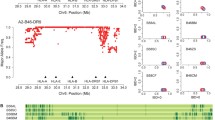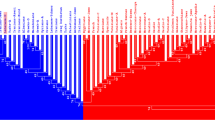Abstract
Although diversity within the HLA-DRB region is predominantly focused in the DRB1 gene, the second expressed DRB loci, DRB3, DRB4, and DRB5, also exhibit variation. Within DRB1 * 15 or DRB1 * 16 haplotypes, four new variants were identified: 1) two new DRB5 alleles, DRB5* 0104 and DRB5* 0204, 2) a haplotype carrying a DRB1 * 15 or * 16 allele without the usual accompanying DRB5 allele, and 3) a haplotype carrying a DRB5* 0101 allele without a DRB1 * 15 or * 16 allele. The evolutionary origins of these haplotypes were postulated based on their associations with the DRB6 pseudogene. Within HLA haplotypes which carry DRB3, a new DRB3 * 0205 allele and one unusual DRB3 association were identified. Finally, two new null DRB4 alleles are described: DRB4 * 0201N, which exhibits a deletion in the second exon, and a second allele, DRB4 * null, which lacks the second exon completely. Gene conversion-like events and variation in the number of functional genes through reciprocal recombination and inactivation contribute to the diversity observed in the second expressed HLA-DRB loci.
Similar content being viewed by others
Author information
Authors and Affiliations
Additional information
Received: 2 November 1996 / Revised: 23 December 1996
Rights and permissions
About this article
Cite this article
Robbins, F., Hurley, C., Tang, T. et al. Diversity associated with the second expressed H L A - D R B locus in the human population. Immunogenetics 46, 104–110 (1997). https://doi.org/10.1007/s002510050248
Issue Date:
DOI: https://doi.org/10.1007/s002510050248




